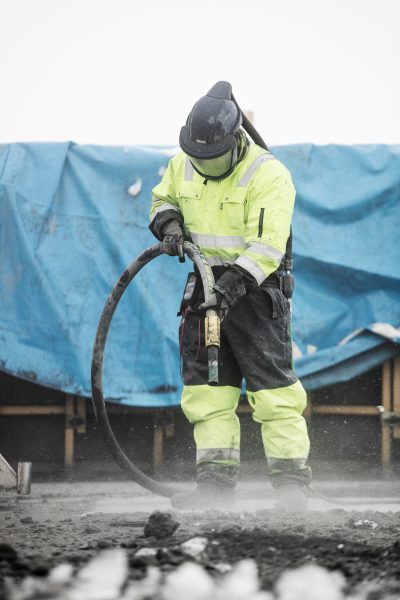Sandblasters are the perfect tool for shot blasting, scraping, stripping, and even cleaning surfaces. However, few people know exactly how they work!
This article will provide you with all the relevant information about sandblasters, how they work, and the different types.
Table of Contents
- What is Sandblasting?
- How Does a Sandblaster Work?
- Types of Sandblasters
- FAQs (Frequently Asked Questions)
What is Sandblasting?
Sandblasting, also referred to as abrasive blasting, is a surface treatment method that is used to clean surfaces and matt glass. Its principal operation is a strong jet of air mixed with a blasting agent. The blasting agent will typically be corundum or garnet sand, which hits the surface at high speed and thus cleans and roughens the metal surfaces in one process.
The required air pressure is generated by special compressors and the powder-like abrasive can either be mixed with water or dry.
The special sand-air mixture is then blasted at high speed via a hose and nozzle system onto a surface for treatment. During the process, surface particles are loosened out due to the abrasive blasting that occurs and then removed.
The surfaces are therefore cleaned of impurities, rust, paint, or scale. Depending on the process, different degrees of cleaning can be achieved.
To properly understand how a sandblaster works, you must first understand the main possibilities of using a sandblaster:
- Rust removal
- Scale removal
- Old paint removal
- Preparatory measures for matting
- Burr removal
- Polishing removal
- Preparation for painting or anti-corrosion agents
- Decorative effects on wood or concrete

How Does a Sandblaster Work?
A sandblasting system, first of all, will consist of the following components:
- Air compressor
- Accumulative receiver
- Main tool
- Containers with abrasive particles
- Automation and control systems
- Connecting hoses
With all this, the principle of operation of a sandblaster can be understood, and it may be comparable to a spray gun. Firstly, the air is supplied to the compressor and when the maximum pressure is reached, air enters the gun. A vacuum is formed, and the airflow draws in the sand. These abrasive particles are accelerated up to 40 m/s as they exit through the nozzle from the gun and impact the treated surface.
The main component of sandblasting is having a compressor that can deliver compressed air at different speeds. The nozzle is used to direct and localize the jet of the abrasive particles. The best material for the nozzle tends to be tungsten carbide.
Note: you should not choose a cast iron or ceramic nozzle, as they have a short life span!
The hoses must be able to withstand high pressures and have minimum internal resistance. Their diameter and length affect the overall performance of the sandblaster.
The sandblaster is equipped with a small tank that must be connected to an air compressor, leading to it sometimes being referred to as a compressor sandblaster gun.
A special material (silica sand or synthetic abrasive sand) is placed inside the tank, both dry, previously filtered, and with defined grain size (sometimes variable). In this way, the pressurized air that passes quickly into the gun will suck the sand which, impacting the material to be treated, is able to remove paints, rust, and oxides.
It does this on all types of surfaces, even those of irregular shapes that may be difficult to treat with abrasive paper.
An example of a sandblaster at work can be seen in the YouTube demonstration below on a rusty hubcap.
Here’s an example of a Le Lematec sandblaster that is readily available on Amazon!
- High quality kit tackles any job around the shop or home; complete with ¼ inch NPT quick connector, extra steel tip, media filter, user manual & media guide
Prices pulled from the Amazon Product Advertising API on:
Product prices and availability are accurate as of the date/time indicated and are subject to change. Any price and availability information displayed on [relevant Amazon Site(s), as applicable] at the time of purchase will apply to the purchase of this product.
Types of Sandblasters
The operation of a sandblaster is related to its type. However, they all share the same common principles.
The three different types of sandblasters are:
- Gravity-fed
- Pressure
- Siphon
Now let’s take a look at each in more detail!
Gravity-Fed Sandblasters
A gravity-fed sandblaster works on the principle that the hopper (filled with silica sand) and the air pipe are connected to the tank. This causes two reactions to occur when the gun trigger is pulled.
First, compressed air is released from the gun air hose when the trigger is depressed, and then an opening is created at the level of the hopper. The silica sand then comes out due to the pressure propagating in the barrel coupled with the force of gravity.
When the trigger of the gun is released, the opening between the hopper and the barrel will close to keep the remaining sand inside of the hopper for further use.
Pressure Sandblasters
Pressure sandblasters are probably the most popular of the three due to their lower cost and ease of use. They are similar to aerosols, simply a large bottle filled under pressure with silica sand.
Their principle of operation, often with two hands, is connecting the sandblaster to the port on the top of the cartridge via a very special hose that can counter the abrasive effects of sand.
When the gun trigger is pulled, air and sand are forced out of the cylinder together. This provides the advantage of a system that has very little if any maintenance and servicing. However, it has a drawback, the sand driven out cannot be collected for reuse and therefore the bottle must be changed frequently.
Siphon Sandblasters
The handyman’s favorite! This type of sandblaster is used to perform cleaning and stripping of surfaces. Made up of three parts: the gun, the pressure tank (air compressor), and the sand tank.
It works on the principle that when the gun is triggered, the air creates the suction of the sand from the tank towards the hose, and then the gun is finally fired into the barrel.
This type of operation is relatively affordable and it can be used continuously as the sand can simply be recollected and placed back into the reservoir. When a large surface needs to be stripped clean, it is usually a siphon media blaster that will be put into action.
If you’re wondering What Size Air Compressor You Need For Sandblasting? then please visit our guide!
FAQs (Frequently Asked Questions)
No, you cannot use actual sand in a sandblaster. When a high-velocity particle of sand impacts a surface it will pulverize on contact releasing a basic component of soil… quartz, cristobalite, or tridymite, which are common forms of free silica. The resulting microscopic silica particle will then become airborne and respirable. If inhaled, it will affect the alveoli of the lungs, creating a condition known as silicosis.
Sandblasting is done using a sandblaster which is comparable to a spray gun. Air is supplied from the compressor and enters the gun. This forms a vacuum, and the airflow draws in the sand which is in a container attached to the gun. These abrasive sand particles are accelerated up to 40 m/s as they exit through the nozzle from the gun and impact the treated surface.
A gravity-fed sandblaster works on the principle that the hopper (typically filled with silica sand) and the air pipe are connected to the tank. This causes two reactions to occur when the gun trigger is pulled. The trigger is depressed and then an opening is created at the level of the hopper to allow the silica sand to come out due to the gravitational force/pressure propagating in the barrel.
If you have any questions regarding how sandblasters work, please leave a comment below, with a photo if applicable, so that someone can help you!

